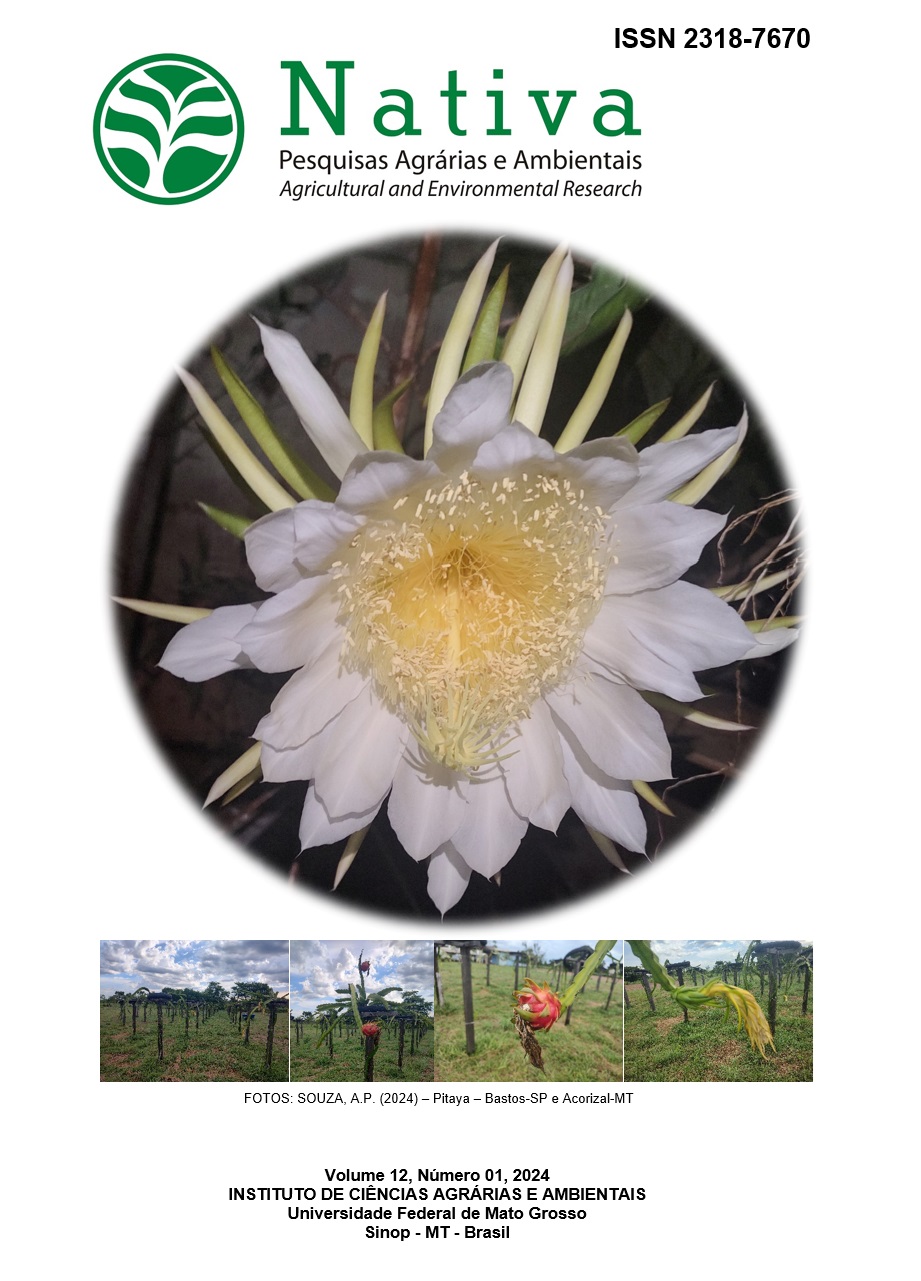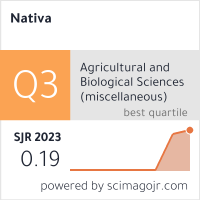EFEITOS DA REGENERAÇÃO FLORESTAL NA CONECTIVIDADE DA PAISAGEM DO ESTADO DE RONDÔNIA, AMAZÔNIA, BRASIL
DOI:
https://doi.org/10.31413/nat.v12i1.15799Palavras-chave:
fragmentação, regeneração, ecologia da paisagemResumo
A manutenção da biodiversidade em ambientes florestais depende da conectividade da paisagem, tal ligação entre os habitats florestais sofrem diretamente com o desmatamento. A restauração da floresta pode proporcionar o retorno da movimentação de indivíduos entre os habitats florestais. Dessa forma, o objetivo deste estudo foi avaliar, por meio de índices de conectividade, a contribuição do aumento das áreas de regeneração florestal na conectividade da paisagem do estado de Rondônia. As imagens utilizadas foram da coleção Landsat. A classificação do solo foi feita na plataforma Google Earth Engine pelo algoritmo Random Forest. Foram calculadas as métricas de conectividade da paisagem, sendo: Índice de Área Conectada Equivalente (ECA) e Diferença de Probabilidade da Conectividade (dPC), ambas calculadas com o software GuidosToolbox. Os resultados revelaram que o estado de Rondônia não apresentou diferenças expressivas com o incremento das áreas de regeneração florestal em ambas as métricas de conectividade da paisagem. O resultado mais notável foi o aumento de importância de conectividade dos nós grandes, fragmentos de grandes dimensões, com o acrescimento das áreas de regeneração. Sendo assim, concluiu-se que as áreas de regeneração florestal contribuíram para a melhoria dos indicadores de conectividade, mas não expressivamente.
Palavras-chave: fragmentação, regeneração, ecologia da paisagem, imagens digitais.
Effects of forest regeneration on landscape connectivity in the state of Rondônia, Amazon, Brazil
ABSTRACT: The maintenance of biodiversity in forest environments depends on landscape connectivity; this linkage between forest habitats is directly affected by deforestation. Forest restoration can facilitate the movement of individuals between forest habitats. Thus, through connectivity indices, this study aimed to evaluate the contribution of increased forest regeneration areas to landscape connectivity in the state of Rondônia. Landsat images were utilized for this analysis. The Random Forest algorithm conducted soil classification on the Google Earth Engine platform. Landscape connectivity metrics were calculated, including the Equivalent Connected Area Index (ECA) and the Connectivity Probability Difference (dPC), both computed with GuidosToolbox software. The results revealed that the state of Rondônia showed no significant disparities with the increase in forest regeneration areas in either landscape connectivity metric. The most notable outcome was the heightened importance of connectivity for large nodes and large-sized fragments with the addition of regeneration areas. Therefore, it was concluded that forest regeneration areas contributed to improving connectivity indicators, albeit not notably.
Keywords: fragmentation; regeneration; landscape ecology; digital image.
Referências
ALMEIDA, C. A.; COUTINHO, A. A.; ESQUERDO, J. C. D. M.; ADAMI, M.; VENTURIERI, A.; DINIZ, C. G.; DESSAY, N.; DURIEUX, L.; GOMES, A. R. High spatial resolution land use and land cover mapping of the Brazilian Legal Amazon in 2008 using Landsat-5/TM and MODIS data. Acta Amazonica, v. 46, n. 3, p. 291-302, 2016. https://doi.org/10.1590/1809-4392201505504
ALVARES, C. A.; STAPE, J. L.; SENTELHAS, P. S.; GONÇALVES, J. L. de M.; SPAROVEK, G. Köppen’s climate classification map for Brazil. Meteorologische Zeitschrift, v. 22, n. 6, p. 711-728, 2013. https://doi.org/10.1127/0941-2948/2013/0507
BATISTELLA, M.; ROBESON, S.; MORAN, E. F. Settlement design, forest fragmentation, and landscape change in Rondônia, Amazônia. Photogrammetric Engineering and Remote Sensing, v. 69, n. 7, p. 805-812, 2003. http://dx.doi.org/10.14358/PERS.69.7.805
BREIMAN, L. Random Forests. Machine Learning, v. 45, p. 5-32, 2001. https://doi.org/10.1023/A:1010933404324
CAVALCANTE, R. B. L.; NUNES, S.; VIADEMONTE, S.; RODRIGUES, C. M. F.; GOMES, W. C.; FERREIRA JR, J. da S.; PONTES, P. R. M.; GIANNINI, T. C.; AWADE, M.; MIRANDA, L. de S.; NASCIMENTO JR, W. R. Multicriteria approach to prioritize forest restoration areas for biodiversity conservation in the eastern Amazon. Journal of Environmental Management, v. 318, p. 115590, 2022. https://doi.org/10.1016/j.jenvman.2022.115590
COCHRANE, M. A.; LAURANCE, W. F. Fire as a large-scale edge effect in Amazonian forests. Journal of Tropical Ecology, v. 18, n. 3, p. 311-325, 2002. https://doi.org/10.1017/S0266467402002237
CONVENTION ON BIOLOGICAL DIVERSITY(CBD). What is Forest Biological Diversity? Disponível em: <https://www.cbd.int/forest/what.shtml>. Acesso em 22 nov 2019.
FEARNSIDE, P. Deforestation of the Brazilian Amazon. Oxford Research Encyclopedia of Environmental Science, 49p., 2017. https://doi.org/10.1093/acrefore/9780199389414.013.102
FRANÇA, L. C. de J.; MORANDI, D. T.; MENEZES, E. S.; MUCIDA, D. P.; DA SILVA, M. D.; LISBOA, G. dos S. Ecologia de paisagens aplicada ao ordenamento territorial e gestão florestal: procedimento metodológicos. Nativa, v. 7, n. 5, p. 613-620, 2019. http://dx.doi.org/10.31413/nativa.v7i5.7363
GUERRA, A.; REIS, L. K.; BORGES, F. L. B.; OJEDA, P. T. A.; PINEDA, D. A. M.; MIRANDA, C. O.; MAIDANA, D. P. F. de L.; SANTOS, T. M. R. dos; SHIBUYA, P. S.; MARQUES, M. C. M.; LAURANCE, S. G. W.; GARCIA, L. C. Ecological restoration in Brazilian biomes: Identifying advances and gaps. Forest Ecology and Management, v. 458, e117802, 2020. https://doi.org/10.1016/j.foreco.2019.117802
HADDAD, N. M.; BRUDVIG, L. A.; CLOBERT, J.; DAVIES, K. F.; GONZALEZ, A.; HOLT, R. D.; LOVEJOY, T. E.; SEXTON, J. O.; AUSTIN, M. P.; COLLINS, C. D.; COOK, W. M.; DAMSCHEN, E. I.; EWERS, R. M.; FOSTER, B. L.; JENKINS, C. N.; KING, A. J.; LAURANCE, W. F.; LEVEY, D. J.; MARGULES, C. R.; MELBOURNE, B. A.; NICHOLLS, A. O.; ORROCK, J. L.; SONG, D.-X.; TOWNSHEND, J. R. Habitat fragmentation and its lasting impact on Earth’s ecosystems. Science Advances, v. 1, n. 2, p. e1500052, 2015. https://doi.org/10.1126/sciadv.1500052
HERNÁNDEZ, A.; MIRANDA, M.; ARELLANO, E. C.; SAURA, S.; OVALLE, C. Landscape dynamics and their effect on the functional connectivity of a Mediterranean landscape in Chile. Ecological Indicators, v. 48, n. 9, p. 198-206, 2014. https://doi.org/10.1016/j.ecolind.2014.08.010
IBGE_Instituto Brasileiro de Geografia e Estatística. Bases cartográficas contínuas 2017. Disponível em: https://www.ibge.gov.br/geociencias/cartas-e-mapas/bases-cartograficas-continuas.html. Acesso em: 13 mar 2023.
INPE_Instituto Nacional de Pesquisas Espaciais. Monitoramento do Desmatamento da Floresta Amazônica Brasileira por Satélite – PRODES. Disponível em: <http://www.obt.inpe.br/OBT/assuntos/programas/amazonia/prodes>. Acesso em: 04 jul 2019.
LANDIS, J. R.; KOCH, G. The Measurement of Observer Agreement for Categorical Data. Biometrics, v. 33, n. 1, p. 159-174, 1977. https://doi.org/10.2307/2529310
LANG, S.; BLASCHKE, T. Análise da Paisagem com SIG. São Paulo: Oficina de Textos, 2009. 424 p.
LAURANCE, W. F.; FERREIRA, L. V.; RANKIN-DE MERONA, J. M.; LAURANCE, S. G.; HUTCHINGS, R. W.; LOVEJOY, T. E. Effects of Forest Fragmentation on Recruitment Patterns in Amazonian Tree Communities. Conservation Biology, v. 12, n. 2, p. 460-464, 1998.
LAURANCE, W. et al. Averting biodiversity collapse in tropical forest protected areas. Nature, v. 489, p. 290-294, set. 2012. https://doi.org/10.1038/nature11318
LEAL, F. A.; ALMEIDA, M. V. de S.; LEAL, G. da S. A.; SANTOS FILHO, F. F. S. Modelagem de corredores ecológicos para conexão entre duas florestas nacionais em Rondônia. Nativa, v. 7, n. 2, p. 204-212, 2019. http://dx.doi.org/10.31413/nativa.v7i1.6686
LUZ, N. B. da; GARRASTAZU, M. C.; ROSOT, M. A. D.; MARAN, J. C.; OLIVEIRA, Y. M. M.; FRANCISCON, L.; CARDOSO, D. J.; FREITAS, J. V. Brazilian National Forest Inventory – a landscape scale approach to monitoring and assessing forested landscapes. Pesquisa Florestal Brasileira, v. 38, e201701493, 2018. https://doi.org/10.4336/2018.pfb.38e201701493
MACARTHUR, R. H.; WILSON, E. O. The theory of Island biogeography. Princeton University Press, 1967. 224p.
NIKOLAKAKI, P.; DUNNETT, N. The use of spatial concepts as a basis for designing a viable-habitat network: Conserving redstart (Phoenicurus phoenicurus) populations in Sherwood Forest, England. Journal for Nature Conservation, v. 13, n. 1, p. 31-48, 2005. https://doi.org/10.1016/j.jnc.2005.01.001
PEREIRA, R. G. de A. Produção da piscicultura de espécies nativas da Amazônia em Rondônia. Caderno de Ciências Agrárias, v. 12, n. 1, p. 1-5, 2020.
PRADO, P. K. B.; SANTOS, A. F. A.; WOJCIECHOWSKI, J. C.; CLAUDINO, W. V.; EISENLOHR, M. A. C. Fragilidade ambiental dos fragmentos florestais do Parque Estadual Cristalino, por métricas da paisagem. Nativa, v. 5, p. 548-554, 2017. http://dx.doi.org/10.5935/2318-7670.v05nespa13
ROCHA, N. C. V.; DE LIMA, A. M. M.; ADAMI, M. Forest Fragmentation and landscape structure in the Guamá River Basin, Eastern Amazon. Geography, Environment, Sustainability, v. 14, n. 3, p. 32-40, 2021. https://doi.org/10.24057/2071-9388-2020-130
SANTOS, J. de P. dos; SOUZA, C. R. de; SILVA, M. A. P. da; SILVA, J. de P.; BOTELHO, S. A. Efetividade na restauração de florestas tropicais: como o desempenho diferencial das espécies e o contexto ecológico influenciam o estabelecimento e ocupação. Nativa, v. 9, n. 4, p. 442-453, 2021. https://doi.org/10.31413/nativa.v9i4.11783
SAURA, S.; ESTREGUIL, C.; MOUTON, C.; RODRÍGUEZ-FREIRE, M. Network analysis to assess landscape connectivity trends: application to European forests (1990-2000). Ecological Indicators, v. 11, n. 2, p. 407-416, 2011. https://doi.org/10.1016/j.ecolind.2010.06.011
SAURA, S.; RUBIO, L. A common currency for the different ways in which patches and links can contribute to habitat availability and connectivity in the landscape. Ecography, v. 33, n. 3, p. 523-537, 2010. https://doi.org/10.1111/j.1600-0587.2009.05760.x
STRAND, J.; CARSON, R. T.; NAVRUD, S.; ORTIZ‐BOBEA, A.; VINCENT, J. R. Using the Delphi method to value protection of the Amazon rain forest. Ecological Economics, v. 131, p. 475-484, 2017. https://doi.org/10.1016/j.ecolecon.2016.09.028
VILLARD, M. A.; METZGER, J. P. Beyond the fragmentation debate: A conceptual model to predict when habitat configuration really matters. Journal of Applied Ecology, v. 51, n. 2, p. 309-318, 2014. https://doi.org/10.1111/1365-2664.12190
VOGT, P.; RIITTERS, K. GuidosToolbox: universal digital image object analysis. European Journal of Remote Sensing, v. 50, n. 1, p. 352-361, 2017. https://doi.org/10.1080/22797254.2017.1330650
USGS_UNITED STATES GEOLOGICAL SURVEY. Landsat Collection 1. Disponível em: <https://www.usgs.gov/land-resources/nli/landsat/landsat-collection-1?qt-science_support_page_related_con=1#qt-science_support_page_related_con>. Acesso em: 07 set 2019.
Downloads
Publicado
Edição
Seção
Como Citar
Licença
Copyright (c) 2024 Nativa

Este trabalho está licenciado sob uma licença Creative Commons Attribution-NonCommercial 4.0 International License.
Direitos Autorais para artigos publicados nesta revista são do autor, com direitos de primeira publicação para a revista. Em virtude de a aparecerem nesta revista de acesso público, os artigos são de uso gratuito, com atribuições próprias, em aplicações educacionais e não-comerciais.
A artigos publicados nessa revista, podem ser reproduzidos parcialmente ou utilizados como referência por outros autores, desde que seja cita a fonte, ou seja, a Revista Nativa.
Copyright for articles published in this journal are the authors, with first publication rights granted to the journal. The journal shows open access, and articles are free to use, with proper attribution, in educational and non-commercial.
The articles published in this journal may be reproduced in part or used as a reference by other authors, provided that the source is quoted.






